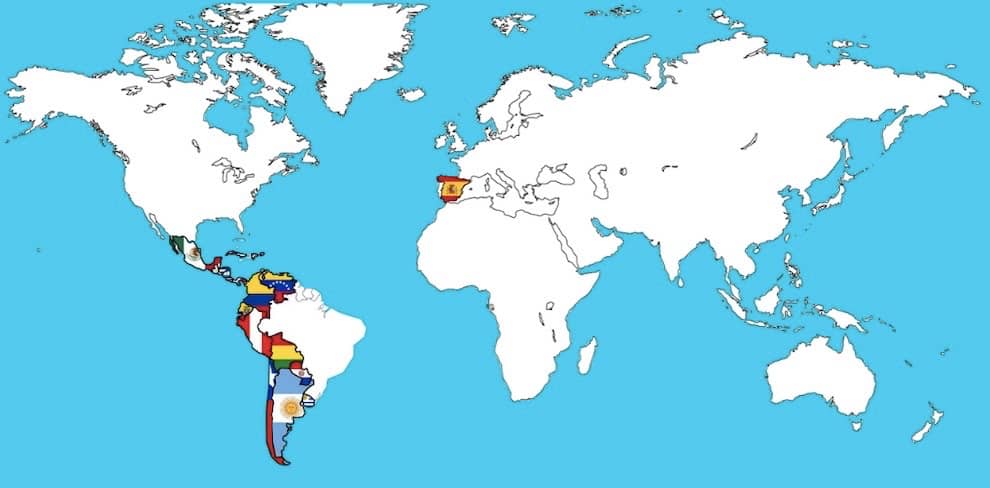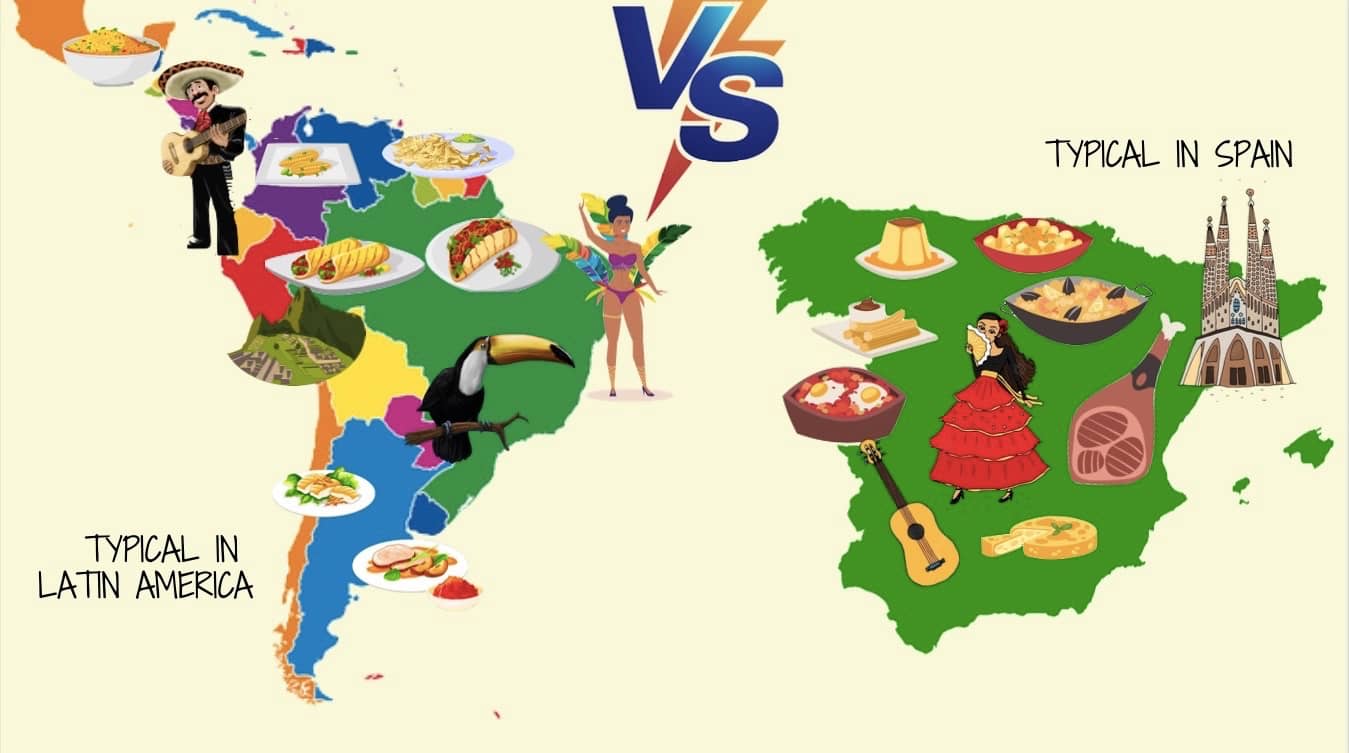Hispanic Countries: A complete list guide to get it right!
September 14, 2022
Win a FREE Trip to Spain!
Exciting Announcement! For the first time, we're thrilled to offer exclusive trips to the heart of Spain - an experience like no other. This isn't your typical tourist journey; it's a unique opportunity to immerse yourself in authentic Spanish culture, alongside real locals and our passionate team.
But there's more! Simply by requesting information about this amazing trip, you'll be entered into a special draw to win a Fully Paid Trip to Spain for Two. And that's not all - everyone who inquires will receive an exclusive bonus gift, valued at $500, available only now.
Ready to Discover the Real Spain?Click Here ↑ to Request Information & Enter the Draw!
Wait a minute… If people speak Spanish in Spain, then why are they not Latinos? A Hispanic country is not the same as a Latino country, and Hispanic does not mean Spain.
I’m sure I just confused you even more with that sentence. This is why I have prepared a complete list guide with everything you need to know about Hispanic Countries.
I’ll describe their culture, give you a complete list of countries considered Hispanic, opinions on Hispanic Heritage Month and tell you the differences between Latinos and Hispanics and why everything seems to be related to the word Spain.
Don’t worry. I’ll give you clear explanations and answers to your most asked questions, so let’s begin with some easy definitions.
Table of Contents ▼ ▶
1. What is a Hispanic Country?
The term Hispanic refers to people who are Spanish-speaking or have origins in a Spanish-speaking country.
Then,
Hispanic countries are all whose official language is Spanish or descends from Spanish-speaking populations.
A complete list of Hispanic countries
| Country | Is It Hispanic? | Is it Latin? |
|---|---|---|
| Argentina | Yes | Yes |
| Bolivia | Yes | Yes |
| Chile | Yes | Yes |
| Colombia | Yes | Yes |
| Costa Rica | Yes | Yes |
| Cuba | Yes | Yes |
| Dominican Republic | Yes | Yes |
| Ecuador | Yes | Yes |
| El Salvador | Yes | Yes |
| Equatorial Guinea | Yes | No |
| Guatemala | Yes | Yes |
| Honduras | Yes | Yes |
| Mexico | Yes | Yes |
| Nicaragua | Yes | Yes |
| Panama | Yes | Yes |
| Paraguay | Yes | Yes |
| Peru | Yes | Yes |
| Puerto Rico | Yes | Yes |
| Spain | Yes | No |
| Uruguay | Yes | Yes |
| Venezuela | Yes | Yes |
Hispanic Country Map
Let’s talk about geography! Here’s a map that can help you understand better where all these countries are located… in case you were wondering.

2. What’s the difference between Hispanic and Spanish?
Let’s talk about geography! Here’s a map that can help you understand better where all these countries are located… in case you were wondering.
- What’s the difference between Hispanic and Spanish?
Spanish means one thing, and Hispanic another. Simple.
We already said the term Hispanic refers to people who are Spanish-speaking or have origins in a Spanish-speaking country.
While in this case, the term Spanish is used to refer to all individuals from (or have origins) from Spain.
But if you’re curious about the other uses of the word Spanish, then you should take a look at this post: The accurate way to call people from Spain and why.
3. What’s the difference between Hispanic and Latino?
Both terms are mainly used as the same thing when they’re not.
Latino is a shortcut for Latin American, which refers to a particular group of countries that are geographically on the American continent, while Hispanic refers to the Spanish-speaking population.
Since almost all of them once were Spanish or French colonies, they have a Spanish Romance Language background. This is why people often refer to all Latinos as Hispanic.
But you should remember that not all Latinos speak Spanish as their mother tongue. Brazil and Haiti, for example, are not considered Hispanic because their official languages are Brazilian and Haitian Creole (respectively), but Latin American because of their geographic location and background.
The same happens with Spain, a European country that speaks Spanish. It is incorrect to say that Spanish people are Latinos since they are not geographically located in Latin America.
Quickly sum up: Hispanic can be generally accepted as a term that only includes people from Spanish-Speaking countries in Latin America, including Spanish territories and Spain. While Latino is the shortcut for countries that come from or have origins from Latin American countries.
4. What’s the Hispanic Heritage Month?
In the United States, Hispanic Heritage Month is celebrated to recognize and embrace the culture, history, and roots of all Americans who have ancestors from Hispanic Countries. Starts from September 15 to October 15.
But why do they celebrate this? This cultural celebration reminds the American people of the influence and contribution Hispanic communities have brought to the US. Also, around September 15, countries like Mexico, El Salvador, Honduras, Guatemala, Costa Rica, and Nicaragua celebrate their Independence. And October 12 (which falls into those days of Heritage Month) is Columbus Day.
Alberto, 22 years old, Nicaraguan, living in the USA: This celebration has a lot of controversies. But I would like to speak from love and not hate. I am proud to recognize the strength of many Hispanic families that come to the US for better living standards. This is why the celebration must be seen as a way to look at the future and how we can all contribute to a better society, not only look at the past.
5. Don’t get confused! Hispanic Culture Facts
The term Hispanic can also be used for the shared cultural traits of this group of people. Hispanic is not a culture per se, but there are a lot of traditions and shared beliefs that make them unique and easy to identify.
Family is a priority, period.
Hispanic families are well known for their concern for other family members. They take care of each other and are responsible for their well-being. There’s a strong family relationship between members, and they celebrate everything together.
Music, dances, and rhythms are very characteristic.
Hispanic people have a unique energy that it’s hard to describe. They create a warm, welcoming environment everywhere they go. Hispanics express themselves and their identity through music, rhythms, dances, colors, and artisans.
Religion plays a crucial role in social structure.
Most Hispanic Societies are based on Catholicism, and they tend to have religion compared to other countries in the world. The most important dates and celebrations in Hispanic cultures are Christmas and Easter.
Indigenous roots, vibrant colors, and nature
Most of them have a lot of respect for their roots and origins. They embrace what their ancestors brought to their culture and keep it alive somehow, including flora and fauna.
I love how Hispanic countries show respect to more senior figures. Generally, these societies care much about values like dignity and self-respect and tend to be very humble.
Traditional food and Mealtime with family

The best part, without a doubt! Hispanic flavors are unique. They represent identity and tradition that evolved and passed through many generations. Seriously you NEED to try some of our main traditional dishes we eat on New Year in Spain. Holidays and special occasions are seen as an opportunity to gather the family together while enjoying traditional tasty dishes. Spanish Mealtime is intended to be a collective and social experience for the whole family.












